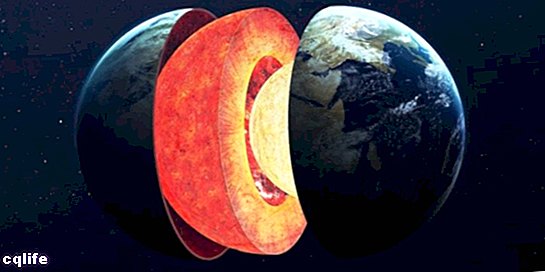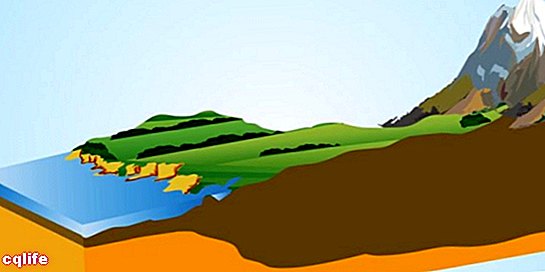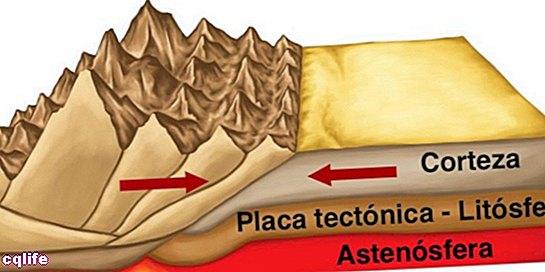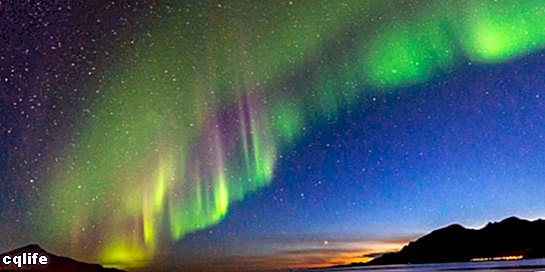- What are the layers of the Earth?
- Earth crust
- Mohorovicic discontinuity
- Lithosphere
- Asthenosphere
- The terrestrial mantle
- Gutenberg's discontinuity
- The Earth's core
We explain what the layers of the Earth are and their characteristics. Also, the Mohorovicic and Gutenberg discontinuities.

What are the layers of the Earth?
The planet Earth it is a spheroid planet of 12,742 kilometers in equatorial diameter, with a slight flattening at the poles. The humanity, along with the other forms of life we inhabit on its surface (the biosphere). But inside, the planet is made up of a set of concentric layers of different composition and dynamics.
The set of these layers make up the geosphere. As with others planets rocky, the layers of the Earth become more and more dense as we move towards its center, which is the planetary core. On the other hand, the deeper we go, the more heat there will be, and we will get closer to the geological past, that is, to the traces of the very formation of the planet.
The layers of the Earth, then, are three: crust, mantle and core, each of which comprises several intermediate layers and has certain characteristics, which we will see separately below.
Earth crust

It is the most superficial layer of the planet, on which we inhabit living creatures, even those that inhabit the depths of the ground.
The deepest hole we have ever dug Humans, called Kola's Superdeep Well (former Soviet Union) is 12,262 meters deep, and is within the range of the earth's crust. It extends from the surface itself (0 km) to 35 kilometers deep.
All the continents they are part of the continental crust. Its composition is mainly felsic rocks (sodium, potassium and aluminum silicates) with a density average 2.7 g / cm3.
Mohorovicic discontinuity
At an average depth of 35 kilometers (70 on the continents and 10 on the oceans) is the so-called Mohorovicic discontinuity or "Moho", a transition zone between the earth's crust and the mantle. It serves as a transition between the less dense crust and the denser magnesium iron silicate rocks that initiate the mantle.
Lithosphere

The lithosphere It is another name for the upper layer of the Earth, ranging between 0 and 100 kilometers deep, that is, it covers the entire earth's crust and the first kilometers of the upper mantle or the asthenosphere.
Its name literally means “stone sphere”. It is fragmented into a set of tectonic plates on which the crust rests, on whose edges the geological accidents known as faults or magmatism occur, giving rise by folding to the moutains and depressions (orogenesis).
The lithosphere can be continental or oceanic, depending on what type of crust is above it, being thicker in the first case and thinner in the second.
Asthenosphere
Located below the lithosphere, between 100 and 400 kilometers deep, is the upper area of the mantle known as the asthenosphere. It is composed of highly ductile silicate materials, either in a solid or semi-molten state due to pressure and high temperatures.
This layer allows the movement over it of the tectonic layers, thus allowing the Continental drift. As we approach its lower edge, however, the asthenosphere loses its properties and quickly becomes rigid.
The terrestrial mantle
The layer that follows the crust, strictly speaking, is the Earth's mantle, which is also the widest layer on the planet, covering 84% of the Earth. It extends from 35 kilometers deep to 2890, where the earth's core begins.
It gets progressively hotter as it moves towards the core. It oscillates between temperatures of 600 ° C to 3500 ° C between its upper band and the vicinity of the nucleus.
The mantle contains rocks in a state of viscous paste, due to the high temperatures and the huge PressureAlthough contrary to what one would think, as one advances towards the nucleus, the rocks tend to be more and more solid, due to the gigantic pressures that force them to occupy the minimum space possible.
The command is subdivided into two regions:
- Upper mantle. From the "Moho" to 665 kilometers deep, where the peridotitic, ultrabasic rocks predominate, mainly composed of olivine magnesium and pyroxene (80% and 20% respectively).
- Lower mantle. Extending from a depth of 665 kilometers to the so-called Gutemberg discontinuity at about 2,900 kilometers deep, it is a very solid and low plasticity zone, of much higher density, despite its temperatures between 1000 and 3000 ° C. It is thought that it could hold more iron than the upper layers, given its proximity to the core.
Gutenberg's discontinuity

Between the Earth's mantle and the planet's core there is another discontinuity, located almost three thousand kilometers deep. Its name pays tribute to its discoverer, the German geologist Beno Gutenberg, who found its existence in 1914.
It is the region where the electromagnetic waves that generate the terrestrial magnetosphere are born, thanks to the friction of the outer core, composed of metals ferromagnetic, and the mantle.
The Earth's core
The innermost area of all the earth's layers is the nucleus. It is located almost 3,000 kilometers deep and extends to the very center of the planet.
Is the region densest planet on the planet, which is saying enough, since Earth is the densest planet in the world. Solar system (5515 kg / m3 on average). This means that the pressure in the core is millions of times that of the surface, and that its temperatures reach up to 6700 ° C.
The nucleus is made up of two different parts:
- The outer core. It reaches a depth of 3400 km and is semi-solid in nature, probably composed of a mixture of iron, nickel and traces of others elements as oxygen and sulfur.
- The inner core. That it is a solid sphere with a radius of 1,220 km, composed mainly of iron, although with a minority presence of nickel and other heavy elements, such as mercury, gold, cesium and titanium. It is possible that the inner core rotates faster than the rest of the layers, and that its gradual cooling generates part of the enormous amount of internal heat of the planet.
